It looks like you're using an Ad Blocker.
Please white-list or disable AboveTopSecret.com in your ad-blocking tool.
Thank you.
Some features of ATS will be disabled while you continue to use an ad-blocker.
39
share:
Strange Moons: Enceladus, The Frozen Water World
Diameter: 513 x 502 x 496 km
Average Surface Temp: 75 Kelvin ( -198 C )
Back in 1789, William Herschel discovered a moon in orbit around Saturn. He found it when he used his brand new 1.2 meter telescope for the first time.
From that time until the first Voyager craft flew by Saturn, little was known about Enceladus. All we knew was it's orbital characteristics, and estimations of it's mass, brightness and density.
That and it orbits Saturn.
Voyager 1 made it's flyby of Saturn first, but the images of Enceladus were from too far and so little detail was gleaned. However, Voyager 1 was able to tell that Enceladus had a highly reflective surface, and that it was embedded in Saturn's "E" ring.
Voyager 2 was able to pass by Enceladus within 87,000 km, which allowed us to obtain higher resolution images of the moon:

The images showed areas of the moon devoid of craters, suggesting a younger surface in some areas than others. It was a surprise to scientist as no theory at the time predicted that such a small body could have a geologically active surface (unlike larger Jupiter moon Io).
The answers to this and other issues came when the Cassini probe arrived at Saturn. The images it was able to take left no doubt as to what the surface was: Ice. Lots of it!
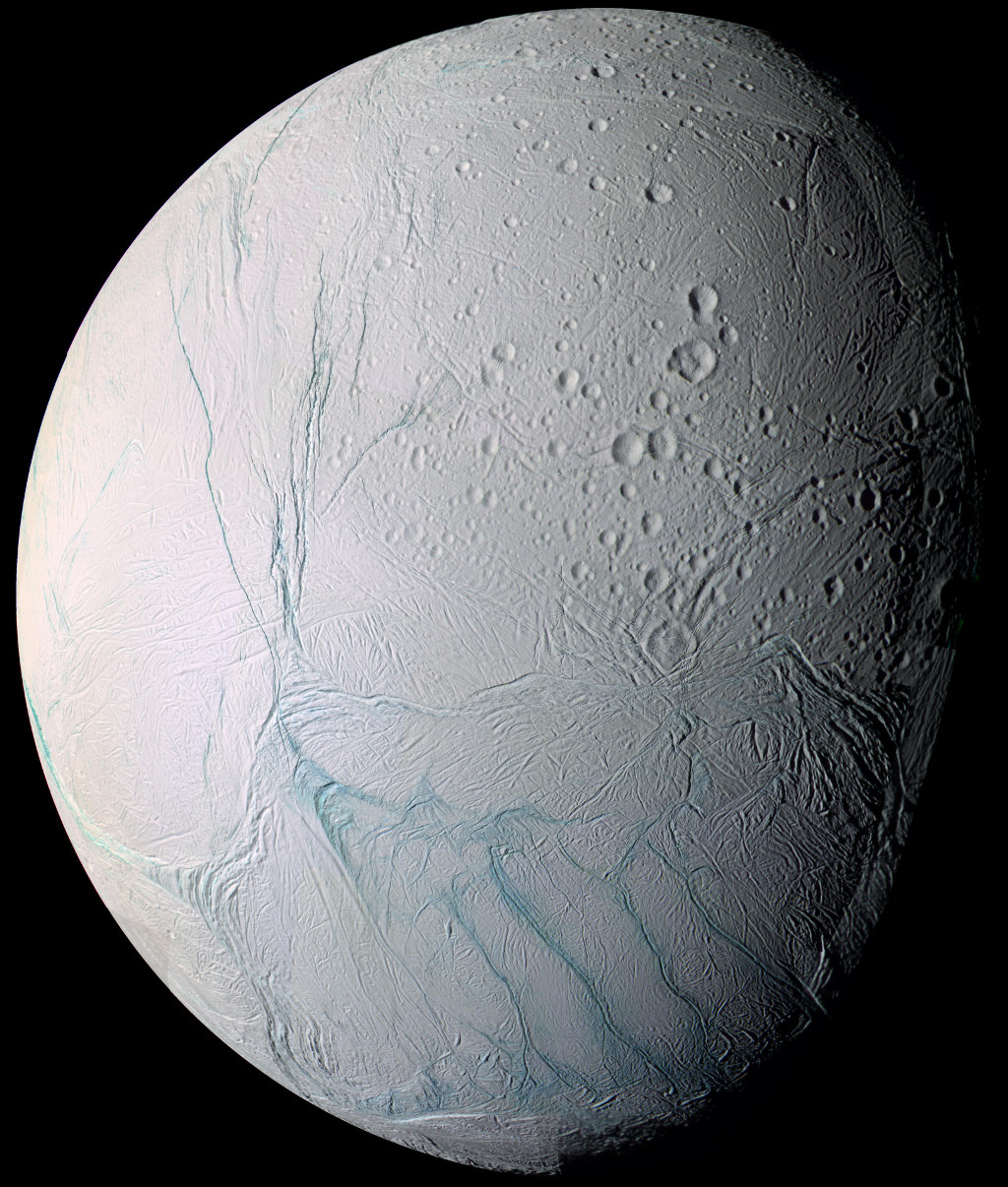
Looking at Enceladus, I was reminded of Jupiter's Europa: an ice covered moon with cracks and crevasse all over it. A water world frozen in time.
However, while it's surface is frozen, it ends up being reborn due to tidal forces that heat up water under that ice and ends up changing the face of the moon.
If you look at the image above, the lower left hand half of the moon reminds me of images of frozen lakes here on Earth that have cracked and refrozen over time.
We have to remind ourselves that Enceladus is a small moon. It would fit inside the state of Texas just fine:
Enceladus sitting next to the Earth:
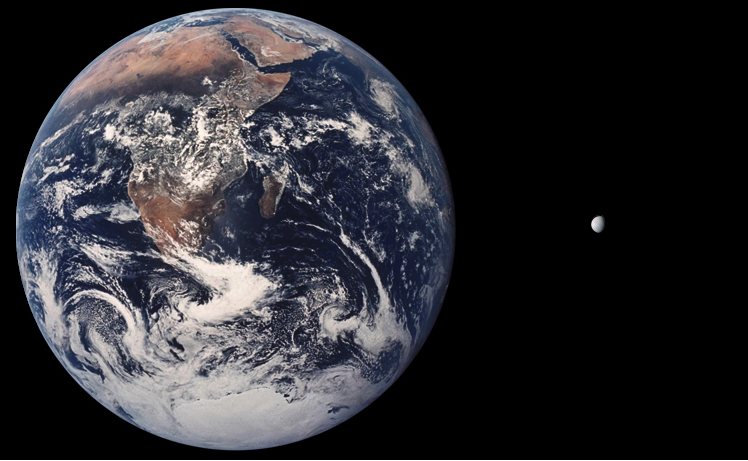
I've seen pictures of glacial flows here on Earth.....but seeing them on a small moon over 750 million miles away from us seems sureal to me:
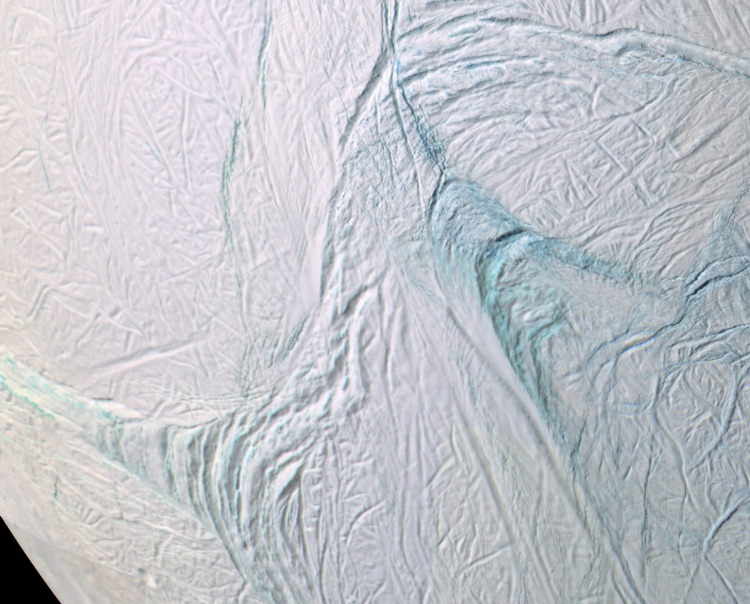
Here is another view of a different side to enjoy:
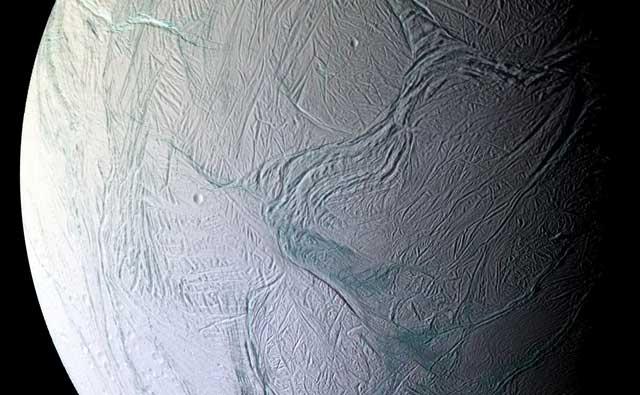
Many of the cracks in the surface remind me of frozen rivers:
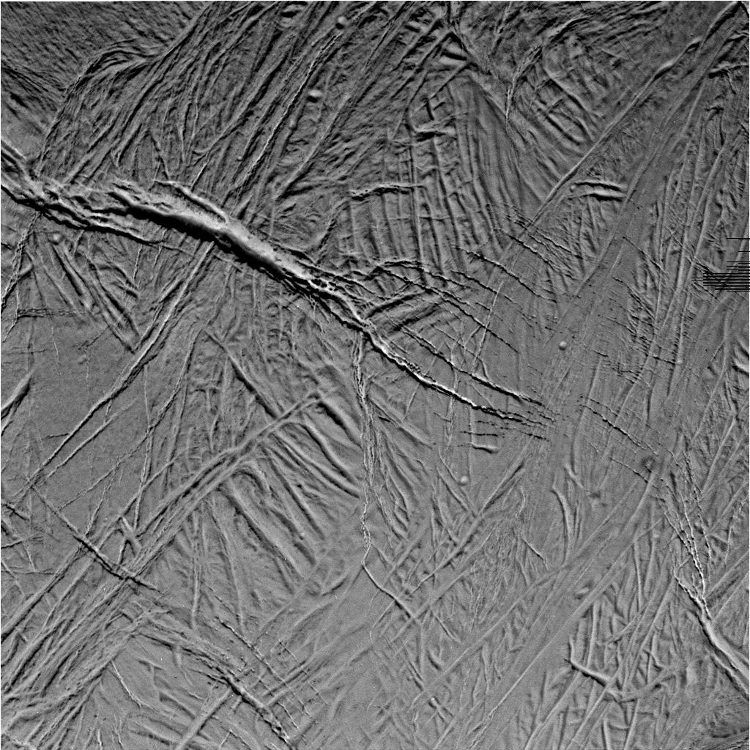
Sometimes, if I let my imagination run a bit, it looks like some of the cracks, especially in the craters, were made by machines of some sort (I don't really believe that, but it's fun to imagine that we're there mining the ice):

Cassini also discovered a few other things about this moon, placing it in my "Strange" catagory. For one thing: it's the source of Saturn's "E" ring:
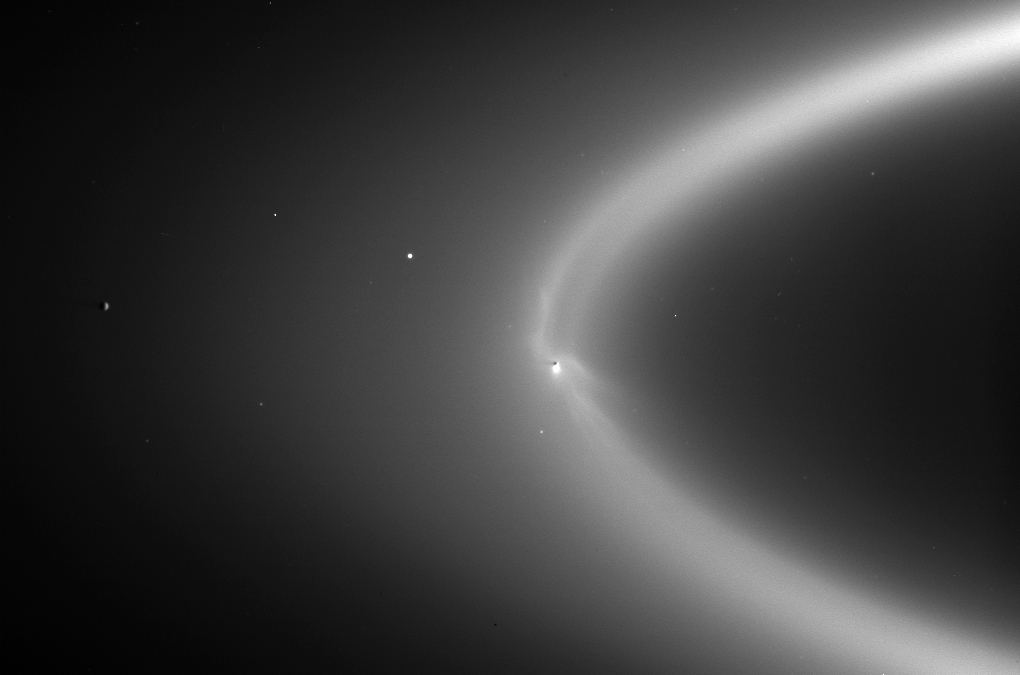
"How is it doing that?" You ask?
It's doing it because of something else Cassini discovered: Geysers of material are spewing out of Enceladus from it's south pole:
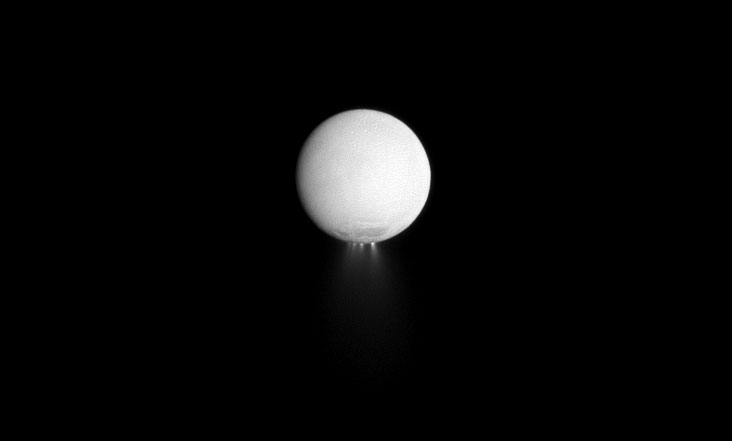
Here is a much closer view:

All of these observations made by Cassini, it's mass, density, how it's surface looks and what it's made out of, and the fact it's spewing material out that is helping make a ring around Saturn, made scientist realize that under all that ice are areas of liquid water.
It's able to be water due to tidal forces that the rocky core of Enceladus has that get's squished and tugged on heats that rock up, which keeps the water liquid.
It also builds up pressure and forces it to spew out from Enceladus:
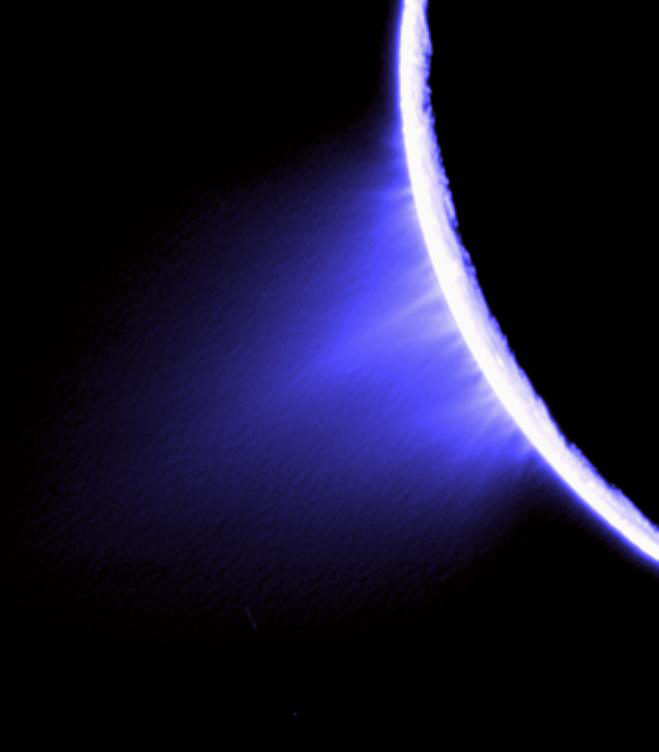
So it's just water......right?
Wrong.
Cassini has made many flybys of Enceladus, and on one of those flybys, was able to pass through one of these geysers. The ion and neutral mass spectrometer on Cassini was able to identify what is in these geysers, and the answer was surprising:
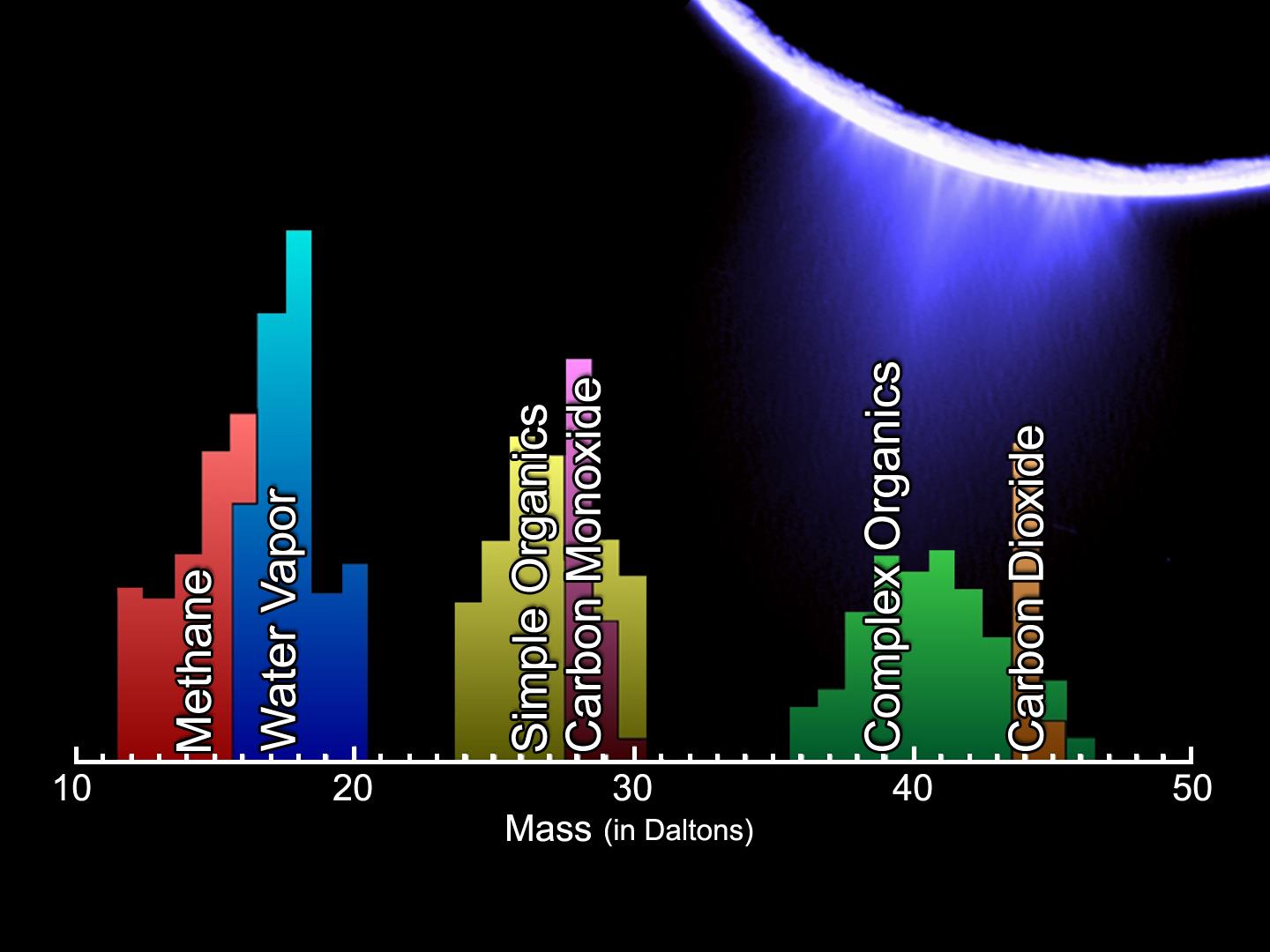
It contains Methane, Simple and Complex Organics!
This discovery alone propled Enceladus to the status of possibly having life below it's icy surface.
So will we ever find out more about Enceladus?
Well there was a joint NASA/ESA mission proposed called the Titan Saturn System Mission (TSSM) to explore the moons of Titan and Enceladus. Estimated price tag of 2.5 billion dollars, with a proposed launch date of 2020 and arriving in 2029.
But the mission to Jupiter and it's moons were given priority. So this mission has been put on the back burner. I doubt that I'll see it happen in my life time.
reply to post by eriktheawful
Excellent! I was really hoping you'd get to Enceladus. Great thread, this is one of the most mysterious moons we have.
btw - I used to have that Molly Hatchet album on 8-track.
Excellent! I was really hoping you'd get to Enceladus. Great thread, this is one of the most mysterious moons we have.
btw - I used to have that Molly Hatchet album on 8-track.
edit on 28-8-2013 by Cuervo because: (no reason given)
I mentioned this before in a previous thread but I'll re-state for the sake of fanaticism. I once asked an OUIJA board if there is life elsewhere in
the solar system, and the board said to look to some of the Moons of the solar system, namely, Encelladus!
I wanna go sledging on Enceladus. Maybe that's where Santa lives!
The detailed Cassini images of this moon are beautiful. So I had a go at the raw images myself at saturn.jpl.nasa.gov... and created a couple of RGB composites using infrared (red channel) and UV (blue channel), with infrared+UV combined for green channel. Here's a mosaic of the two images:
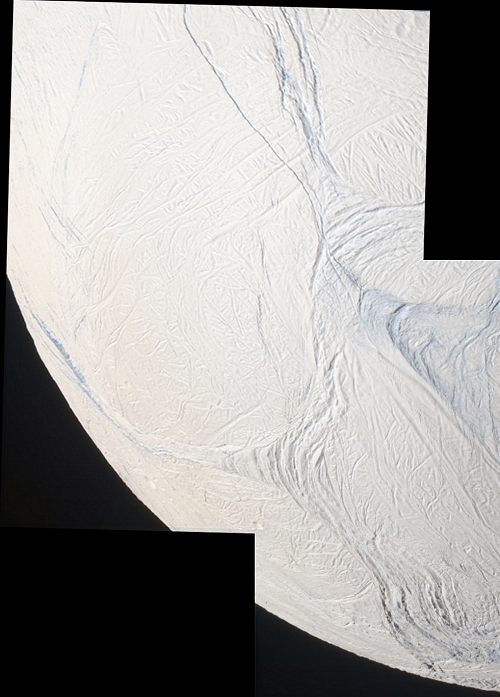
Full-sized (and sharpened) version: www.pictureshack.us...
Link to the raw images I used: saturn.jpl.nasa.gov...
So the exposed ice in the cracks and ravines absorbs infrared light, but reflects UV. Interesting.
The detailed Cassini images of this moon are beautiful. So I had a go at the raw images myself at saturn.jpl.nasa.gov... and created a couple of RGB composites using infrared (red channel) and UV (blue channel), with infrared+UV combined for green channel. Here's a mosaic of the two images:

Full-sized (and sharpened) version: www.pictureshack.us...
Link to the raw images I used: saturn.jpl.nasa.gov...
So the exposed ice in the cracks and ravines absorbs infrared light, but reflects UV. Interesting.
reply to post by wildespace
Except for the craters, when I look at Enceladus, It makes me think that's what Snowball Earth would have looked like.
Except for the craters, when I look at Enceladus, It makes me think that's what Snowball Earth would have looked like.
S&F, amazing post. Those images are really amazing and thank you for your effort in gathering this information.
Keep the good work
Keep the good work
Here's a colour image of Enceladus' ice geisers, created from raw images taken in April 2013 using
infrared and blue filters:
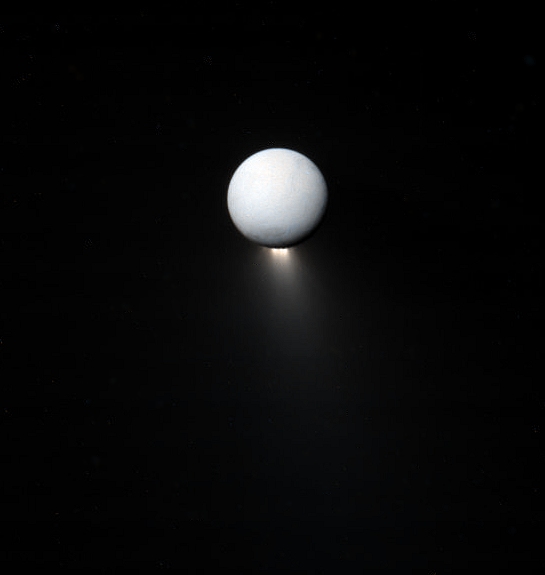
Here's another one, using infrared, blue, and UV filters:
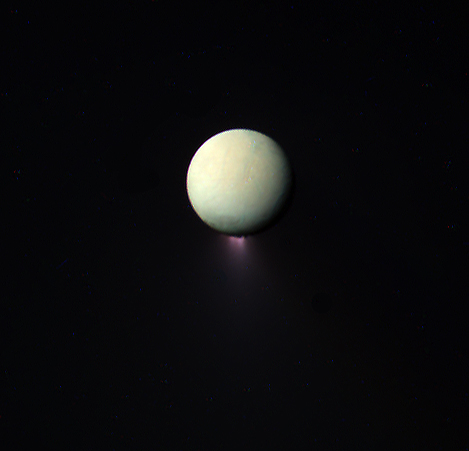
Shame they didn't include green-filter images. It would be cool to see a true-colour image, as if taken by an ordinary digital camera.

Here's another one, using infrared, blue, and UV filters:

Shame they didn't include green-filter images. It would be cool to see a true-colour image, as if taken by an ordinary digital camera.
edit on
6-4-2014 by wildespace because: (no reason given)
The fresh, clean ice that dominates its surface gives Enceladus probably the most reflective surface of any body in the Solar System, with albedo of
0.99 (where 1 means that absolutely all the incoming light is reflected or scattered, and 0 means absolutely all incoming light is absorbed).
This gives Enceladus a remarkable snow-white appearance (being even somewhat brighter than fresh snow), in contrast to Saturn's other moons or even Saturn itself.
Here are some pictures that show this:
Enceladus among other Saturn moons: www.pictureshack.us...
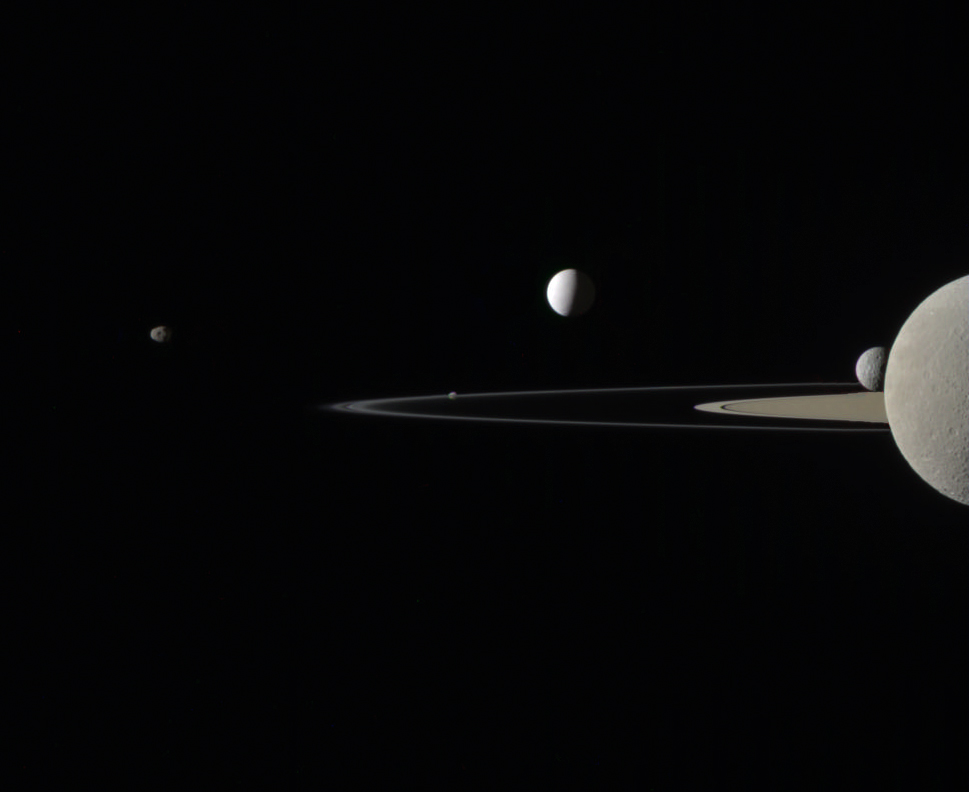
Enceladus and the Rings: www.pictureshack.us...
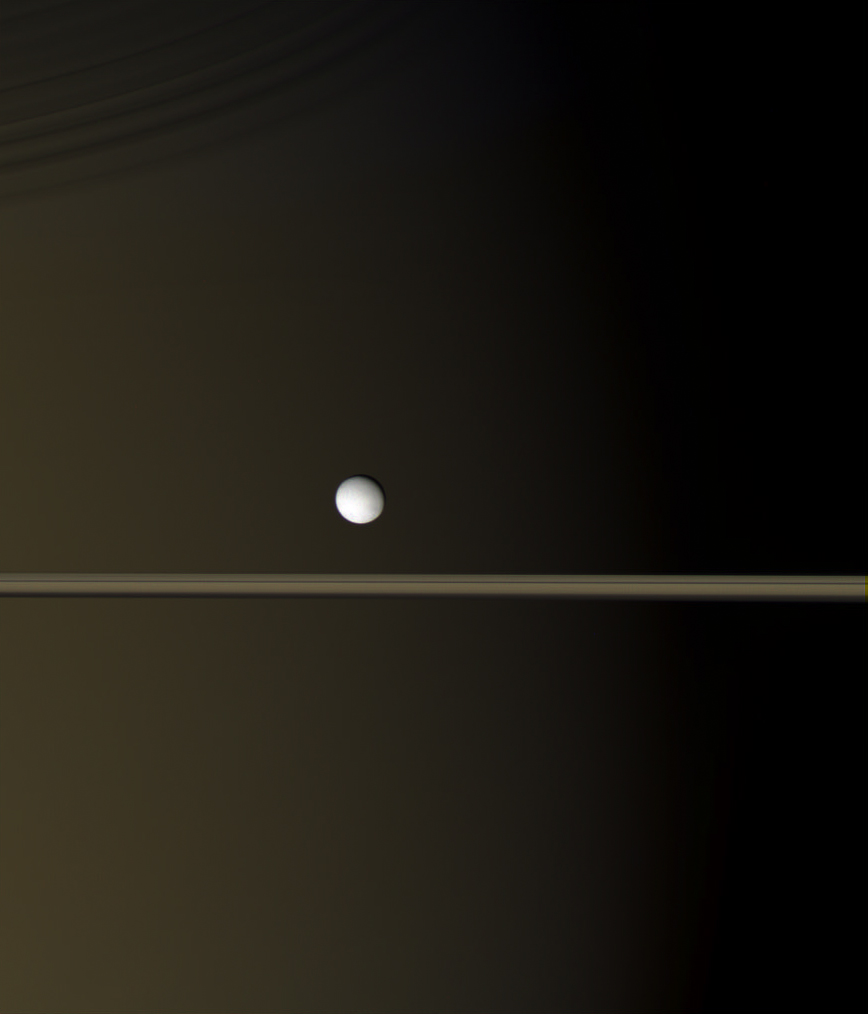
Enceladus: www.pictureshack.us...
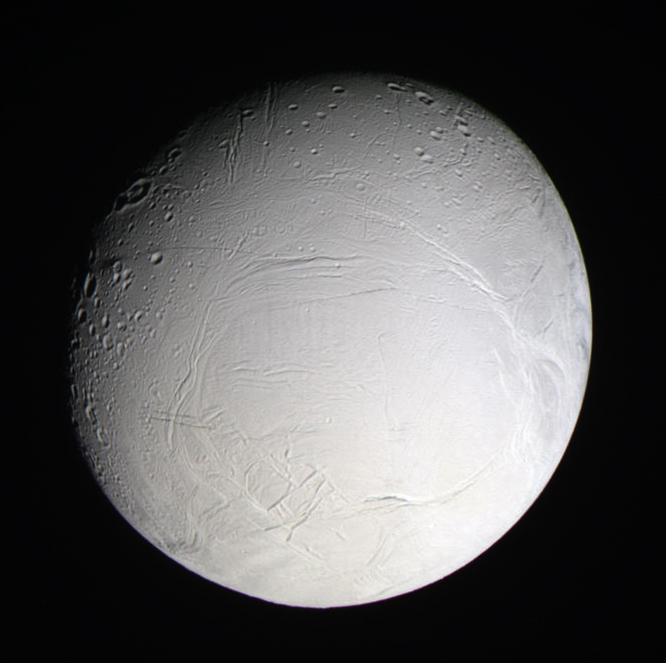
Images created by me from the raw black&white Cassini spacecraft images.
Albedo-wise, Enceladus' closest rivals are Eris and Venus, while Saturn and Jupiter have albedo of only about 0.34
I'd love to see Enceladus with my own eyes (preferrably from a tourist space cruise ship), that would be quite a treat.
This gives Enceladus a remarkable snow-white appearance (being even somewhat brighter than fresh snow), in contrast to Saturn's other moons or even Saturn itself.
Here are some pictures that show this:
Enceladus among other Saturn moons: www.pictureshack.us...

Enceladus and the Rings: www.pictureshack.us...

Enceladus: www.pictureshack.us...

Images created by me from the raw black&white Cassini spacecraft images.
Albedo-wise, Enceladus' closest rivals are Eris and Venus, while Saturn and Jupiter have albedo of only about 0.34
I'd love to see Enceladus with my own eyes (preferrably from a tourist space cruise ship), that would be quite a treat.
edit on
13-7-2014 by wildespace because: (no reason given)
a reply to: eriktheawful
I am reviving this 2013 discussion with new and relevant information:
www.space.com...
HOT SPRINGS ON SATURN'S MOON ENCELADUS POWERED BY HYDROTHERMAL VENTS
www.space.com...
HIDDEN OCEAN FOUND ON SATURN'S ICY MOON ENCELADUS, COULD POTENTIALLY SUPPORT LIFE
www.space.com...
WHAT IT WOULD BE LIKE TO LIVE ON SATURN'S MOONS TITAN AND ENCELADUS
I am reviving this 2013 discussion with new and relevant information:
www.space.com...
HOT SPRINGS ON SATURN'S MOON ENCELADUS POWERED BY HYDROTHERMAL VENTS
www.space.com...
HIDDEN OCEAN FOUND ON SATURN'S ICY MOON ENCELADUS, COULD POTENTIALLY SUPPORT LIFE
www.space.com...
WHAT IT WOULD BE LIKE TO LIVE ON SATURN'S MOONS TITAN AND ENCELADUS
NASA's Cassini spacecraft just made a close fly-by of Enceladus, producing some captivating and unprecedented images. Unless I'm mistaken, this is the
closest we've ever been to this moon: saturn.jpl.nasa.gov...
Here's a great oblique view of the north polar region, covered in a multitude of cracks and fractures:
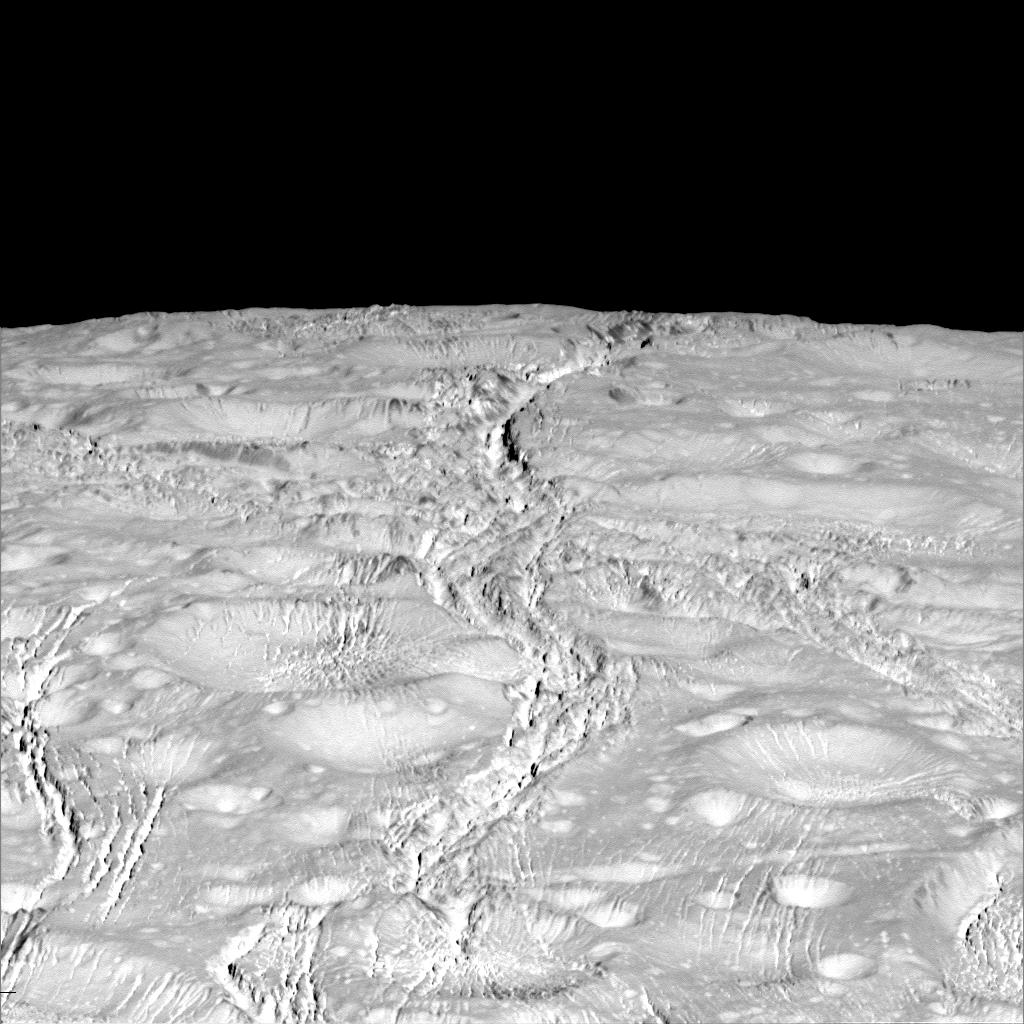
Another cool photo is of these craters:
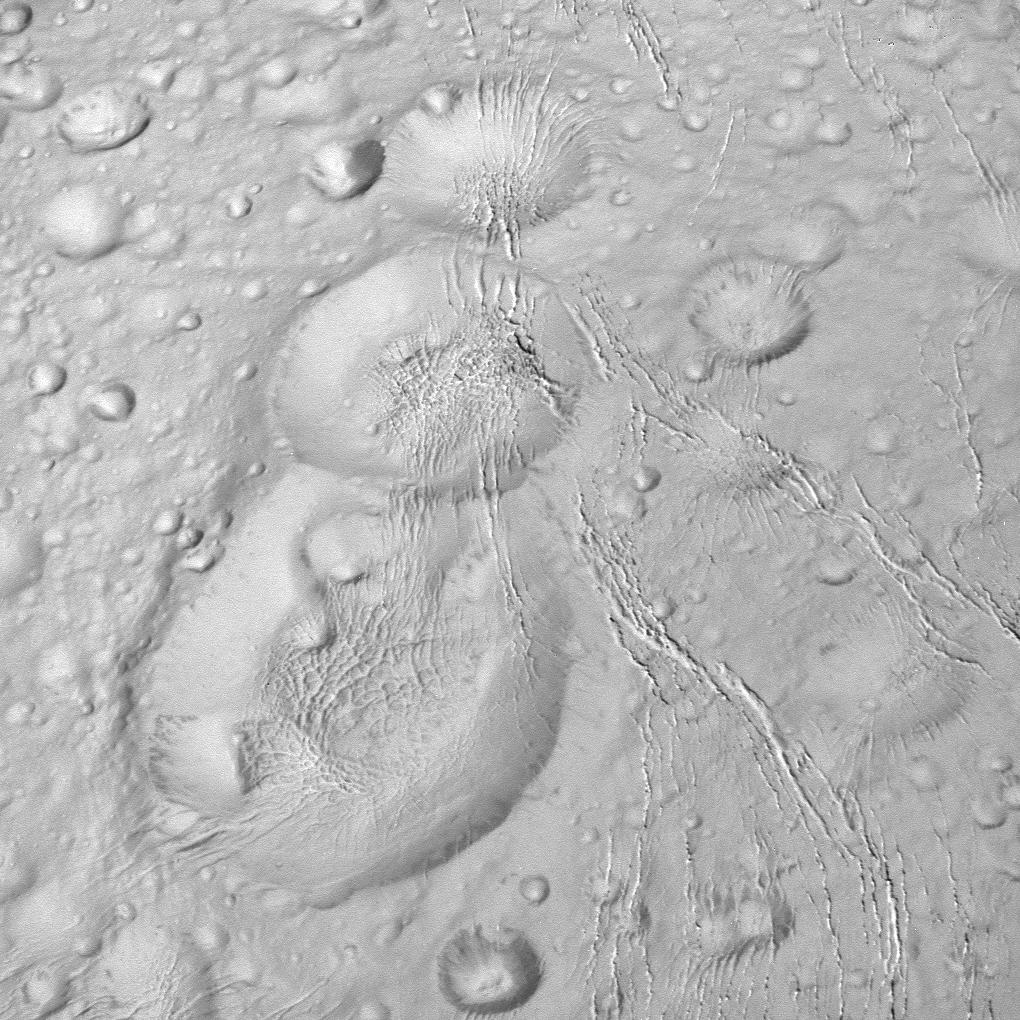
This is a great development in getting to know this moon better. Images from further away gave an impression of a smoother surface.

NASA's Cassini spacecraft has begun returning its best-ever views of the northern extremes of Saturn's icy, ocean-bearing moon Enceladus. The spacecraft obtained the images during its Oct. 14 flyby, passing 1,142 miles (1,839 kilometers) above the moon's surface. Mission controllers say the spacecraft will continue transmitting images and other data from the encounter for the next several days.
Here's a great oblique view of the north polar region, covered in a multitude of cracks and fractures:

NASA's Cassini spacecraft zoomed by Saturn's icy moon Enceladus on Oct. 14, 2015, capturing this stunning image of the moon's north pole.
Scientists expected the north polar region of Enceladus to be heavily cratered, based on low-resolution images from the Voyager mission, but high-resolution Cassini images show a landscape of stark contrasts. Thin cracks cross over the pole -- the northernmost extent of a global system of such fractures. Before this Cassini flyby, scientists did not know if the fractures extended so far north on Enceladus.
Another cool photo is of these craters:

NASA's Cassini spacecraft spied this tight trio of craters as it approached Saturn's icy moon Enceladus for a close flyby on Oct. 14, 2015. The craters, located at high northern latitudes, are sliced through by thin fractures -- part of a network of similar cracks that wrap around the snow-white moon.
The image was taken in visible light with the Cassini spacecraft narrow-angle camera on Oct. 14, 2015 at a distance of approximately 6,000 miles (10,000 kilometers) from Enceladus. Image scale is 197 feet (60 meters) per pixel.
This is a great development in getting to know this moon better. Images from further away gave an impression of a smoother surface.

A cool new closeup of Enceladus from Cassini: www.nasa.gov...
I made this colour image using infrared, green, and UV filtered images: s29.postimg.org...
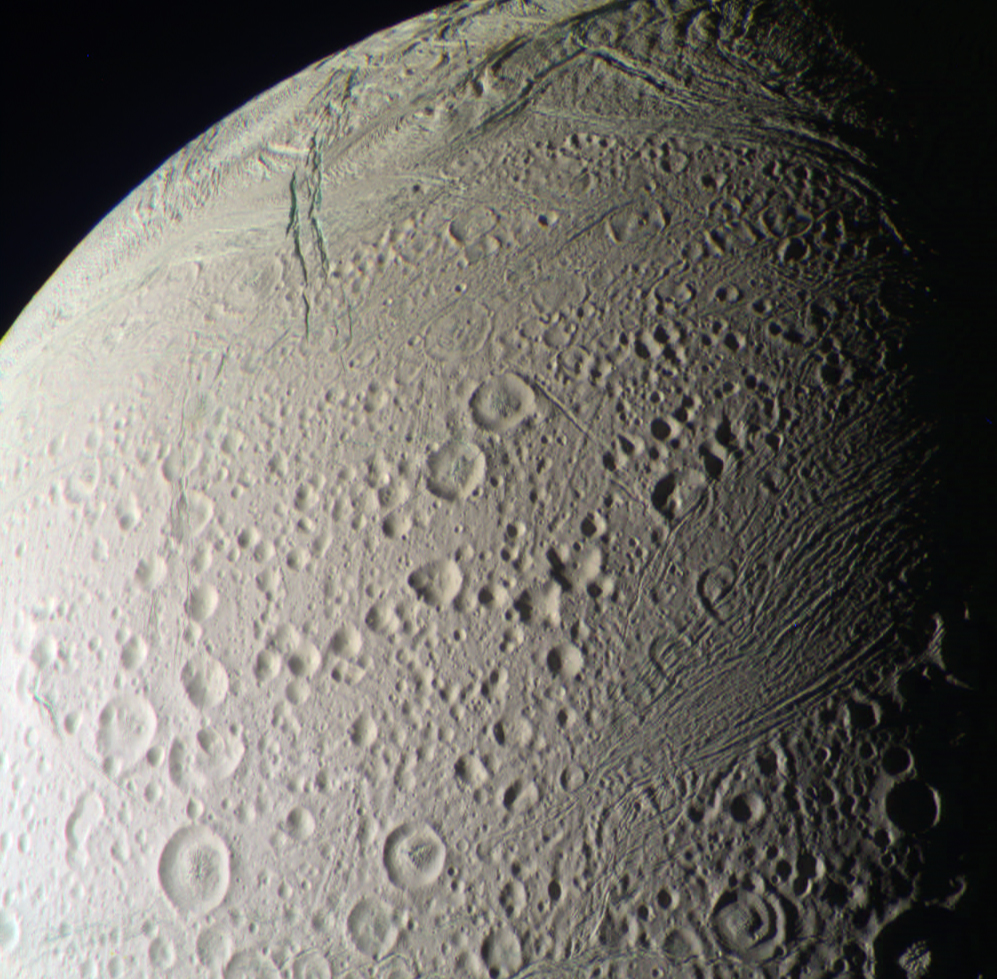
Enceladus is a world divided. To the north, we see copious amounts of craters and evidence of the many impacts the moon has suffered in its history. However, to the south we see a smoother body with wrinkles due to geologic activity.
Most solar system bodies lacking an atmosphere are heavily cratered like Enceladus' (313 miles or 504 kilometers across) northern region. However, the geologic activity in the south, including the famous plume above the moon's south pole, can erase craters and leave a younger, smoother-looking surface.
I made this colour image using infrared, green, and UV filtered images: s29.postimg.org...

Beautiful S&F... When I see pics like these or watch some space fantasy (Star Trek/Star wars) I am actually ashamed that the majority effort and money
goes to war and killing people on our little blue dot of a world. If all the defense budgets of the countries were pooled together for getting mankind
off this egg no telling what we would be doing today and discovering. Instead we sit and speculate on what might be someplace instead of actually
setting foot on many of these far away moons/worlds ....
new topics
-
University of Texas Instantly Shuts Down Anti Israel Protests
Education and Media: 30 minutes ago -
Any one suspicious of fever promotions events, major investor Goldman Sachs card only.
The Gray Area: 2 hours ago -
God's Righteousness is Greater than Our Wrath
Religion, Faith, And Theology: 7 hours ago -
Electrical tricks for saving money
Education and Media: 10 hours ago -
VP's Secret Service agent brawls with other agents at Andrews
Mainstream News: 11 hours ago
top topics
-
VP's Secret Service agent brawls with other agents at Andrews
Mainstream News: 11 hours ago, 9 flags -
Cats Used as Live Bait to Train Ferocious Pitbulls in Illegal NYC Dogfighting
Social Issues and Civil Unrest: 15 hours ago, 8 flags -
Nearly 70% Of Americans Want Talks To End War In Ukraine
Political Issues: 12 hours ago, 4 flags -
Electrical tricks for saving money
Education and Media: 10 hours ago, 4 flags -
Sunak spinning the sickness figures
Other Current Events: 12 hours ago, 3 flags -
Late Night with the Devil - a really good unusual modern horror film.
Movies: 14 hours ago, 2 flags -
Any one suspicious of fever promotions events, major investor Goldman Sachs card only.
The Gray Area: 2 hours ago, 2 flags -
The Good News According to Jesus - Episode 1
Religion, Faith, And Theology: 17 hours ago, 1 flags -
God's Righteousness is Greater than Our Wrath
Religion, Faith, And Theology: 7 hours ago, 0 flags -
University of Texas Instantly Shuts Down Anti Israel Protests
Education and Media: 30 minutes ago, 0 flags
active topics
-
Any one suspicious of fever promotions events, major investor Goldman Sachs card only.
The Gray Area • 4 • : BeyondKnowledge3 -
Nearly 70% Of Americans Want Talks To End War In Ukraine
Political Issues • 29 • : andy06shake -
God's Righteousness is Greater than Our Wrath
Religion, Faith, And Theology • 25 • : andy06shake -
Russia Ukraine Update Thread - part 3
World War Three • 5730 • : Arbitrageur -
VP's Secret Service agent brawls with other agents at Andrews
Mainstream News • 43 • : Hakaiju -
Everest-sized ‘Devil comet’ Pons-Brooks Visible Now
Space Exploration • 17 • : Compendium -
Nakedeye Mother of Dragons Comet Is Here!
Space Exploration • 5 • : Compendium -
HORRIBLE !! Russian Soldier Drinking Own Urine To Survive In Battle
World War Three • 38 • : BernnieJGato -
15 Unhealthiest Sodas On The Market
Health & Wellness • 43 • : JPRCrastney -
University of Texas Instantly Shuts Down Anti Israel Protests
Education and Media • 0 • : FlyersFan
39
